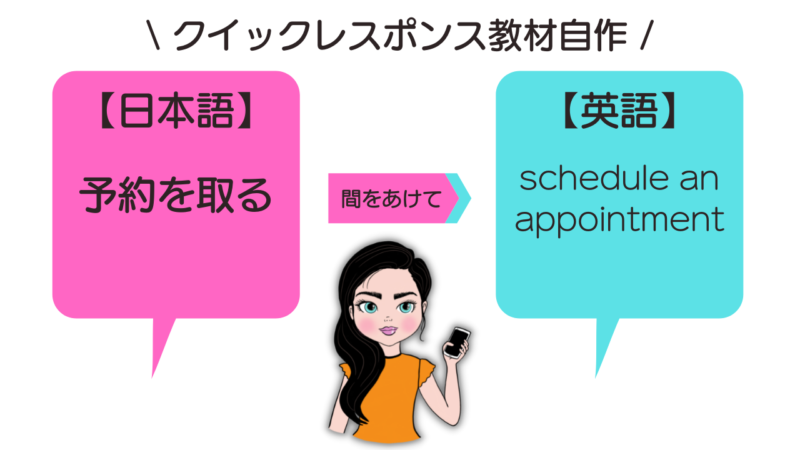こんにちは。
現役医療通訳士のSuzyです。
今回は、ネイティブ翻訳家監修 Suzyのクイックレスポンス教材シリーズ❷「総合診療科」をお届けします。
クイックレスポンスとは、日本語と英語を対にして表現を覚える暗記のトレーニングです。
独学で医療通訳の勉強をしている方や、医療通訳2次試験受験予定の方に活用していただければいいなと思います。
- ネイティブ翻訳家チェック済みで自然な表現
- 実際の医療通訳場面で出てくる表現を厳選
- 一問一答
もし、すでにあなたが日頃使っている定型文や、覚えている言い回しがあれば、それを追加したり省いたり、自由にカスタマイズしていきましょう。
- ネイティブ翻訳家のチェック済みなので、自然な表現を覚えることができる
- あなたに合ったクイックレスポンス音声を自作し、無駄を省く
- 実践的な定型文を覚えることができる
- 覚えることで通訳の瞬発力がつく
あなたがこの教材を使ってクイックレスポンス音源を自作し、医療通訳2次試験に自信を持って臨んでもらえたら嬉しいなと思います。
クイックレスポンスって何?クイックレスポンス教材の作り方って?と思っている方は、こちらをご覧ください↓
医療英語初心者さんのためにSuzyの無料動画オンライン講座公開中↓
では早速 let’s go!
【医療通訳教材】「総合診療科」General Internal Medicine 一問一答 英語でクイックレスポンス

症状の種類
どのような症状がありますか。
What symptoms do you have?
| 日本語 | 英語 | 医療者が質問する場合(例文) |
| 発熱 | fever | 熱がありますか? Do you have a fever? |
| 咳 | cough | 咳がありますか? Do you have a cough? |
| 鼻水 | runny nose | 鼻水が出ていますか? Do you have a runny nose? |
| 痰 | phlegm | 痰が出ますか? Do you have phlegm?/ Do you cough up phlegm? |
| ぜーぜー言う (喘鳴ぜんめい) | wheezing | ぜーぜー言いますか? Are you wheezing at all? |
| 胸痛 | chest pain | 胸の痛みがありますか? Do you have chest pain? |
| 息苦しさ | difficulty breathing | 息苦しさがありますか? Do you have difficulty breathing? |
| 脈の乱れ | irregular pulse | 脈の乱れはありますか? Do you have an irregular pulse? |
| 冷汗 | cold sweat | 冷や汗が出ますか? Are you having cold sweats? |
| 胸が重たい | heaviness in chest | 胸に重い感じがありますか? Are you feeling any heaviness in your chest? |
| 動悸がする | have palpitations | 動悸がしますか? Are you having palpitations? |
| 身体がだるい | feel sluggish | だるい感じがありますか? Do you feel sluggish? |
| むくみ(顔・手・足) | swelling on the face/hands/feet | 顔・手・足にむくみがありますか? Do you have swelling on the face/hands/feet? |
| 手足が冷たい | cold hands and feet | 手足が冷たいですか? Are your hands and feet cold? |
| 立ちくらみがする | feel lightheaded | 立ちくらみがありますか? Do you feel lightheaded? |
| 疲れやすい | get tired easily | 疲れやすいですか? Do you get tired easily? |
| 息切れ | shortness of breath | 息切れがありますか? Do you have shortness of breath? |
| めまい | dizziness/ feel dizzy | めまいがありますか? Do you feel dizzy at all? |
| 血便 | bloody stool/ blood in stool | 便に血が混じっていますか? Have you noticed any blood in your stool? |
| 頻尿 | frequent urination / urinate frequently | 普段より尿の回数が多いですか? Have you been urinating more frequently than usual? |
| 血尿 | bloody urine/ blood in urine | 尿に血が混じっていますか? Have you noticed any blood in your urine? |
| 麻痺 | paralysis | 麻痺がありますか? Do you have paralysis? |
| 不眠 | insomnia | 不眠がありますか? Do you have insomnia? |
| 下痢 | diarrhea | 下痢がありますか? Do you have diarrhea? |
| かゆみ | itchiness/ feel itchy | かゆいところはありますか? Do you feel itchy anywhere? |
| 痛み | pain | 痛いところはありますか? Are you feeling any pain anywhere? |
| げっぷ | burping | げっぷが出ますか? Have you been burping? |
| 食欲減退 | loss of appetite | 食欲が減っていますか? Are you experiencing a loss of appetite? |
| 体重 | weight | 現在の体重と20歳の時の体重では、 どちらが重いですか? Which is heavier, your current weight or your weight at the age of 20? |
| 体重減少 | weight loss/ lose weight | 体重が減っていますか? Are you experiencing weight loss? |
| 血を吐く | vomit blood | 血を吐きましたか? Have you vomited blood? |
| 食べ物がのどにつかえる | food stuck in the throat | 喉に食べ物が詰まった感じがありますか? Do you feel like you have food stuck in your throat? |
胸痛(がある場合)の種類
それはどのような胸の痛みですか。
What is the chest pain like?
| 日本語 | 英語 | 医療者が質問する場合(例文) |
| 締め付けられるような痛み | squeezing pain | 締め付けられるような痛みがありますか? Do you have a squeezing pain? |
| 焼けるような痛み | burning pain | 焼けるような痛みがありますか? Do you have a burning pain? |
| ちくちくするような痛み | tingling pain | ちくちくするような痛みがありますか? Do you have a tingling pain? |
| 刺すような痛み | stabbing pain | 刺すような痛みがありますか? Do you have a stabbing pain? |
| 鈍い痛み | dull pain | 鈍い痛みがありますか? Do you have a dull pain? |
便の性質
便の性状について教えてください。
Please tell me about your stool.
| 日本語 | 英語 | 医療者が質問する場合(例文) |
| 灰白色 (かいはくしょく) | grayish-white | 灰白色の便ですか? Is your stool a kind of grayish-white? |
| 茶色 | brown | 茶色の便ですか? Is your stool brown? |
| 黒色 | black | 黒い便ですか? Is your stool black? |
| 血便 | bloody stool/ blood in stool | 便に血が混ざっていますか? Is there blood in your stool? |
| 水様便 | watery | 水っぽい便ですか? Is your stool watery? |
| 軟便 | soft | いつもより柔らかい便ですか? Is your stool softer than usual? |
| 硬い便 | hard | いつもより硬い便ですか? Is your stool harder than usual? |
症状が出現する時
症状はどのようなときに現れますか。
When do you usually have symptoms?
| 日本語 | 英語 | 医療者が質問する場合(例文) |
| 起きた時 | when wake up | 起きた時に症状がありますか? Do you have symptoms when you wake up? |
| 就寝中 | during sleep | 就寝中に症状がありますか? Do you have symptoms during sleep? |
| 階段や坂道を 歩くとき | when going up and down stairs and slopes | 階段や坂道を上り下りするときに、 何か困ることはありますか? Do you have any problems when going up and down stairs or slopes? |
| 徐々にひどくなって きている | gradually getting worse | 症状は徐々にひどくなってきていますか? Are your symptoms gradually getting worse? |
| 出たり消えたりする | come and go | 症状は出たり出なかったりしますか? Do your symptoms come and go? |
| 絶え間なく、 続いている | constant | 症状は絶え間なく、続いていますか? Are your symptoms constant? |
| 疲労を感じた時に ひどくなる | worsens when feeling tired/ get worse when feeling tired | 疲労を感じた時に症状はひどくなりますか? Do your symptoms worsen/get worse when you are feeling tired? |
| 食事と関係している | associated with meals/ come around when eating | 症状は食事と関係していますか? Are your symptoms associated with meals? 食事をすると症状が現れますか? Do your symptoms come around when you eat? |
| 座ることにより、 楽になる | gets better when sitting down/ sitting make it better | 座ることにより、 症状は楽になりますか? Do your symptoms get better when you are sitting down? Does sitting make your symptoms better? |
その他の質問
| 日本語質問・説明 | 英語質問・説明(例文) |
| お通じは何回ありますか。 | How many times a day do you have bowel movements? |
| その症状はいつからありますか。 | When did the symptoms start? |
| 最初に症状に気づいたのはいつですか? | When did you first notice the symptoms? |
| この症状はどのくらい続いていますか? (症状継続期間) | How long have you had these symptoms? |
| この症状はどのくらい続きますか?/ 症状はどのくらいで治まりますか? (一回の症状の長さ) | How long do the symptoms take before going away again? |
| どのくらいの頻度で症状が出ますか? | How often do your symptoms come on? |
| その症状の程度を数字で表すと、 どのぐらいですか。 | On a scale of 1 – 10, how severe is your symptom? |
| 症状を緩和させるものは ありますか。 | Is there anything that can alleviate your symptoms? |
「〜はありますか?」の英訳は
Do you〜? や Are you〜? など様々ですが、
覚えにくいと感じる場合は、統一して
“Have you been experiencing (名詞形)?”
“Have you been -ing?”
にする方法もオススメです。
【医療通訳教材】英語クイックレスポンス教材の作り方

Suzyがおすすめするクイックレスポンスでは、スマホの音声録音機能を使って教材を自作します。
まず日本語を言います。
その後数秒間を空けて、英語を言います。
それを録音して自分だけのオリジナル教材を作るという方法です。
クイックレスポンスについて詳しく書いた記事はこちらです↓
医療通訳試験対策クイックレスポンス教材シリーズを作ろうと思った理由

この教材シリーズを作ろうと思った理由は2つあります。
一つは、私が医療通訳の学習をしていた頃、教材になり得る無料で良質な情報がなかったからです。
ネット検索すれば英語の問診や医療表現がすぐに見つかります。
しかし残念ながらそれらは文法が違っていたり、不自然な英語表現のものが多く、納得できる質の良いものが見つかりませんでした。
今回私が作ったこの教材は、ネイティブ翻訳家チェック済みです。
せっかく覚えるなら、あなたには正しい表現を覚えて欲しい。
そんな思いからこの教材を作りました。
もう一つの理由は、クイックレスポンストレーニングは、本当に力がつくトレーニングであり、ぜひあなたに行なって頂きたいトレーニングだからです。
クイックレスポンストレーニングの目的は「定型文を覚え、通訳のストレスを軽減すること」です。
せっかく覚えるなら、ぜひSuzyの教材を使って、正しい表現を身につけて下さい。
クイックレスポンス教材の作り方は、こちらをご覧ください↓
今回も、最後まで読んで頂きありがとうございました♪




コメント